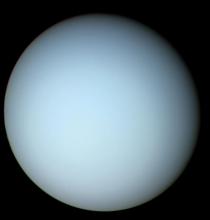You are here
Uranus

The poles of most planets aim away from the plane of the solar system; like Earth's poles, they point roughly north and south. But the poles of Uranus point east and west, close to the plane of its orbit around the Sun. As a result, its north pole aims at the Sun at the beginning of northern summer, and away from the Sun at the start of southern summer. That gives the planet's northern and southern hemispheres 42 years of sunlight followed by 42 years of darkness. This sideways tilt also creates weather patterns unlike those on any other planet, with winds and clouds changing directions with the seasons.
Detecting and tracking the clouds on Uranus is difficult, however. Uranus is so far away that it appears as little more than a fuzzy green blob in ground-based telescopes. A layer of haze atop the atmosphere gives Uranus a uniform blue-green color, hiding most of the cloud formations that move around the planet. Not until recent years, when astronomers began using telescopes that could overcome the distorting effects of Earth's atmosphere, did they begin to see detailed features. Infrared and ultraviolet instruments attached to these telescopes penetrate the haze, allowing astronomers to see deeper into the planet's atmosphere.
Even then, there's not a lot to see. Uranus receives little heat from the Sun, and it does not produce much on its own, so there is no energy source to produce the dramatic cloud bands and weather systems seen on other worlds.
Like Jupiter and Saturn, an envelope of hydrogen and helium lies below the thin upper layers of Uranus' atmosphere. On Uranus, though, the layer of hydrogen and helium is not as thick as on the larger planets, extending perhaps only one-fifth of the distance down from its cloudtops.
A liquid or partially frozen mixture of water, methane, and rocky minerals may lie beneath the hydrogen and helium. Unlike the region where the oceans and air meet on Earth, though, there probably isn't a sharp boundary between the layers of Uranus. The atmospheric pressure is so great that the liquid and gas merge in a slushy transition zone. This zone surrounds a dense, rocky core.
Narrow rings encircle Uranus, but their material is darker than charcoal, so astronomers didn't discover them until 1977, when the rings blocked the light of a star that was about to pass behind Uranus. The rings are the thinnest of any planet in the solar system, consisting of a single layer of particles. Some of the particles are as large as SUVs, though, which is far larger than most particles in the rings of other planets. These large particles suggest that the rings formed fairly recently, when a small moon was pulverized by a collision with a comet or asteroid.
Literary Moons: Titania, Oberon, Ariel, and Umbriel
For a man who made his reputation by counting and plotting the locations of thousands of stars, astronomer John Herschel had a poetic heart. In 1851, he named the four largest moons of Uranus. Instead of picking characters from mythology, he turned to the works of William Shakespeare and Alexander Pope. He named Oberon and Titania for the king and queen of the fairies from Shakespeare's A Midsummer Night's Dream. Ariel and Umbriel were spirits in Pope's The Rape of the Lock.
Titania is Uranus' largest moon. Small impact craters and long, tall cracks scar its icy crust. The cracks probably formed as the gravity of Uranus and its other moons pulled and twisted Titania.
The most interesting moon may be Miranda, which has canyons up to 12 miles (20 km) deep. It, too, may have been reshaped by the gravitational pull of Uranus and its moons.
Uranus's Moons
| 1. Cordelia 2. Ophelia 3. Bianca 4. Cressida 5. Desdemona 6. Juliet 7. Portia |
8. Rosalind 9. Mab 10. Belinda 11. Perdita 12. Puck 13. Cupid 14. Miranda |
15. Francisco 16. Ariel 17. Umbriel 18. Titania 19. Oberon 20. Caliban 21. Stephano |
22. Trinculo 23. Sycorax 24. Margaret 25. Prospero 26. Setebos 27. Ferdinand |
Viewing Guide
♅ With clear, dark skies and good vision, Uranus can be viewed with the naked eye! In fact, a small telescope could reveal its tiny, green disk! It will be brightest from October 11 - December 17.
Exploration
Only one spacecraft has ever visited Uranus. Voyager 2 flew past the giant planet in 1986.
At a Glance
| Discovery |
| 1781, William Herschel |
| Name |
| Greek sky god, first ruler of the Titans |
| Average Distance from Sun |
| 1,783,939,400 miles 2,870,972,200 km 19.2 Astronomical Units |
| Mass |
| 14.4 times Earth's mass |
| Equatorial Diameter |
| 31,764 miles 51,118 km |
| Length of Day |
| 17 hours, 14 minutes |
| Length of Year |
| 84 Earth years |
| Surface Gravity |
| 0.86 that of Earth (If you weigh 100 pounds, you would weigh about 86 pounds on Uranus) |
| Known Moons |
| 27 as of January 2006 |
Teacher Copies
Request a free copy of The Solar System or Beyond the Solar System for your classroom. Bulk copies are available for $1.50 each in quantities of 30 or more. Shipping is included. Call 512-471-5285 for orders of 30 or more.
 The Astro Guides for the Solar System and Beyond the Solar System are supported by the National Aeronautics and Space Administration under Grant Nos. NNG04G131G and NAG5-13147, respectively.
The Astro Guides for the Solar System and Beyond the Solar System are supported by the National Aeronautics and Space Administration under Grant Nos. NNG04G131G and NAG5-13147, respectively.


